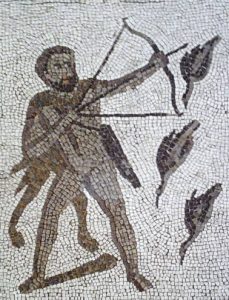One of the distinguishing features of the First World War was the widespread use of chemical weapons. Chemical gases of various lethality, including mustard gas, phosgene and tear gas, were used to disable and kill enemy defenders. Although chemical weapons played a major role during the Great War, its usage can be dated to a much earlier period of history.
One of the earliest references to the use of chemical weapons in western literature can be found in the Greek myth of Heracles, in which the hero dips his arrows in the blood of the Hydra to make them toxic. It has also been claimed that poisoned arrows were mentioned by Homer in both his epics, the Iliad and the Odyssey.

(Hercules killing the Stymphalian birds with toxic arrows. Detail of The Twelve Labours Roman mosaic from Llíria -Valencia, Spain-)
Records of the use of chemical weapons also appear in the ancient civilizations of the East. In India, for instance, the use of poisons during warfare can be found in both the Mahabharata and the Ramayana. Moreover, recipes for poisonous weapons can be found in Kautilya’s Arthashastra, which dates to India’s Mauryan period. In China, there are writings that describe the use of toxic gases by defenders of a city. The toxic fumes, produced by burning balls of mustard or other toxic vegetables, are pumped into tunnels dug by a besieging army using bellows.
Read more HERE
Ask me anything
Explore related questions





